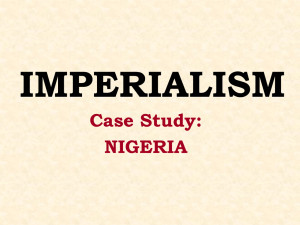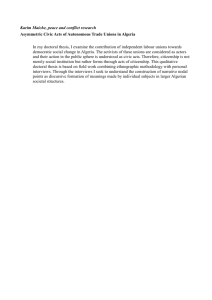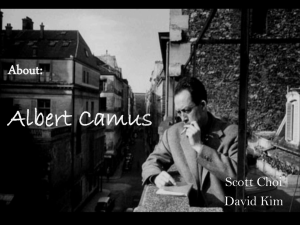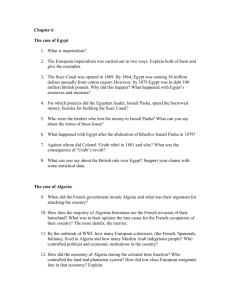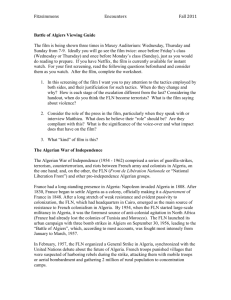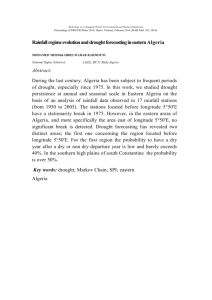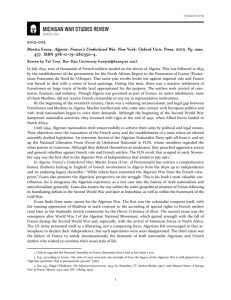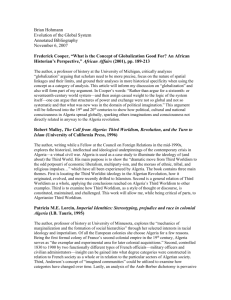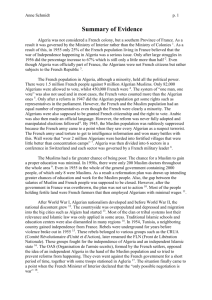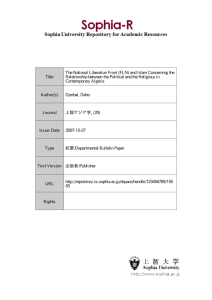to read this book's introduction.
advertisement
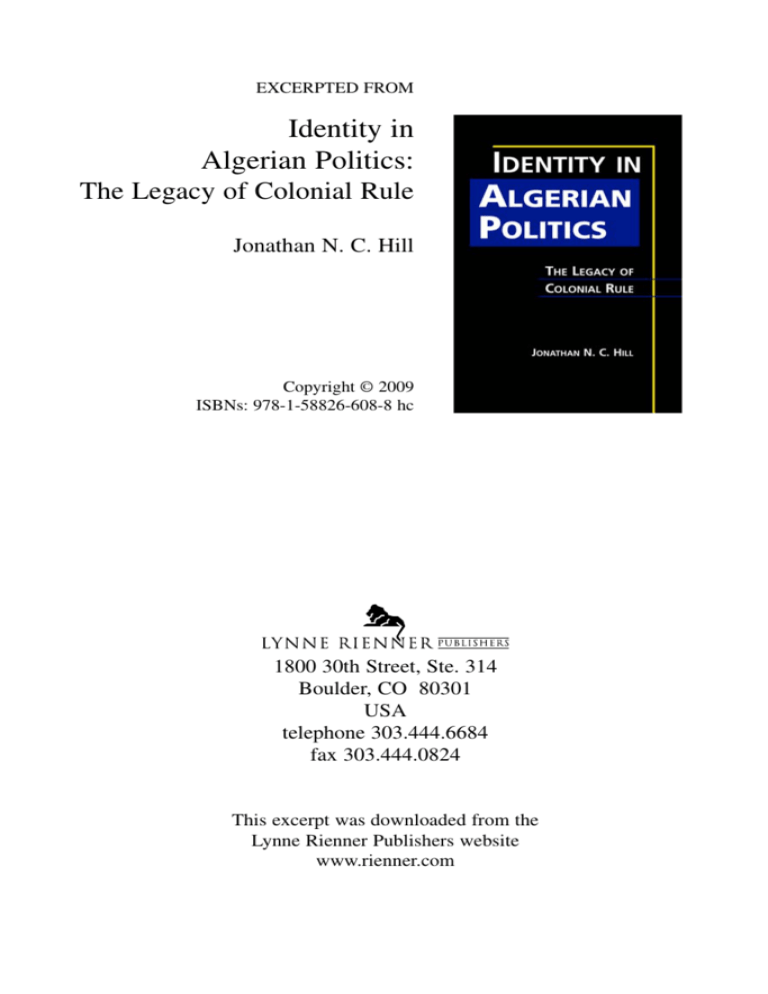
EXCERPTED FROM Identity in Algerian Politics: The Legacy of Colonial Rule Jonathan N. C. Hill Copyright © 2009 ISBNs: 978-1-58826-608-8 hc 1800 30th Street, Ste. 314 Boulder, CO 80301 USA telephone 303.444.6684 fax 303.444.0824 This excerpt was downloaded from the Lynne Rienner Publishers website www.rienner.com H-FM 5/7/09 5:30 PM Page v Contents Acknowledgments vii 1 Introduction 1 2 French Colonial Rule and Its Enduring Legacies 7 3 Algerian Nationalism and the War of Liberation 37 4 Independence and the Challenges of Nation Building 71 5 Economic Crisis and the Descent into Violence 113 6 National Identity and the Ongoing Struggle 167 Bibliography Index About the Book 205 211 223 v H-1 5/7/09 5:31 PM Page 1 1 Introduction “THE COLONISED MAN,” FRANTZ FANON famously declared, “finds his freedom in and through violence.”1 Perhaps nowhere were his words more applicable than in colonial Algeria, the country whose struggle for independence he embraced as his own. On 1 November 1954, small bands of poorly armed men, members of a newly created rebel group called the National Liberation Front (Front de Libération Nationale, FLN), crouched and huddled in the freezing night in anticipation of the attacks they were about to make. Their targets—a gendarmerie barracks, a police station, some stores of tobacco and grain, and various telephone wires—were concentrated mainly in the département (administrative division) of Algiers in the far north of the country. But events did not go according to plan. Panic gripped some, and they abandoned their missions. Excitement got the better of others, and they launched their attacks prematurely, enabling the security forces to raise the alarm and make sufficient noise to deter their more patient comrades waiting elsewhere. Yet, from this inauspicious start, the FLN sustained and expanded its uprising, recruiting, arming, organizing, and directing tens of thousands of men and women. Its armed rebellion formed the central strand, the immutable core, of its campaign to drive France from Algeria, to bring an end to over a century of French rule. Through violence the FLN aimed to convince France—its politicians, generals, and civilian population—that it could not afford the blood-price for staying in the country. By ambushing army units, attacking police stations, blowing up railway lines, cutting telephone wires, demolishing buildings, assassinating government officials, and terrorizing the European community, by killing, maiming, wounding, and destroying, the FLN strove to make Algeria unendurable for France. The violence unleashed by the FLN was itself a response to that visited on the Muslim population by the colonial regime and European settlers. No quarter was ever given to those, such as the members of the Mukrani tribe, 1 H-1 5/7/09 5:31 PM 2 Page 2 Identity in Algerian Politics who took up arms against the colonial state, or who, like the rioters at Sétif and Guelma, attacked and killed Europeans. Yet the real violence perpetrated by colonial rule took the form of a thousand petty abuses inflicted daily on ordinary Muslim men and women by the agents of the colonial state— policemen, gendarmes, soldiers, and bureaucrats. The source of this violence was a political, economic, social, and cultural order that labeled Muslims inferior and, because of that, afforded them only negligible rights and liberties. In seeming contradiction to the doctrines of assimilation and Mission Civilisatrice (civilizing mission) that came increasingly to guide and shape French policy in and for Algeria, France steadfastly refused to grant the Muslim populace the same political and civil rights enjoyed by its own citizens. The marginalization and abuse of the Muslim population this gave rise to was encouraged and, on many occasions, demanded by the European settler community that developed during the course of the nineteenth and twentieth centuries. Numbering just under one million men, women, and children by 1954, it exerted a political influence both in Algeria and France far beyond its small size. Finding natural allies among the ranks of French conservatives, the settlers were well organized and financed, and able to block or emasculate most legislation they did not agree with. The violence unleashed by colonial rule has remained an ever-present blight on Algeria. During the first few months of independence, the country was riven by division and discord as various factions fought for control of the new state. Eventually Ahmed Ben Bella emerged victorious, but he continued to be confronted by numerous armed challenges and was eventually overthrown in a military-led coup d’état. Under his successor, Houari Boumedienne, Algeria enjoyed its greatest period of stability, social harmony, and economic prosperity. But even then, it had to endure several rebellions and was rocked by at least two attempts on Boumedienne’s life. Following his death in 1979, armed uprisings against the government became more frequent as the country was gripped by growing political, economic, and social instability. President Chadli Benjedid’s government responded by introducing sweeping democratic reforms that brought the Islamic Salvation Front (Front Islamique du Salut, FIS) to the cusp of power. Determined to stop its impending victory, the army intervened in January 1992, sparking a bitter and bloody civil war that lasted for the remainder of the decade. And even when, in the late 1990s, the military gained a decisive edge over the insurgents, several terror groups have continued to attack the government and ordinary Algerians. The centrality of violence to Algeria’s ongoing development demands that every effort is made to understand its character—why it occurs, whom it involves, for what reasons, and with what consequences. And the importance of this task is raised still further by the appalling human cost it has H-1 5/7/09 5:31 PM Page 3 Introduction 3 exacted. Since the fighting began in the early 1990s, between 120,000 and 180,000 people, many of them civilians, have lost their lives. And that is to make no mention of the thousands more who have been imprisoned, tortured, raped, abused, disappeared, and forced to leave their homes. The primary goal of this book, therefore, is to assist in these efforts. And it seeks to do so by looking at how disagreements over national identity have given rise to and helped sustain the fighting and bloodshed. At times this violence has placed the very integrity of Algeria in jeopardy. The late 1960s, in particular, were full of danger as the fledgling republic threatened to tear itself apart. On other occasions, the government’s ability to rule effectively in certain parts of the country has been severely impaired. Indeed, for much of the early 1990s, vast tracts of the country’s interior lay beyond Algiers’ control. But consistently, it has been ordinary men and women who have paid most dearly. The prolonged, and at times chronic, instability and insecurity this violence has given rise to has prompted successive governments to try to unite the country behind their leadership and bind its various regions, communities, and ethnic groups more closely together. And like the governments of many other African countries that were once colonized by a foreign power, they have attempted to achieve all this through a process of nation building. Integral to this process is the development of a national identity. Such an identity, along with the very act of its construction and promotion, is intended to distinguish and help bind the nation’s members together. But as well as rendering Algerians distinct from their Moroccan and Tunisian neighbors, yet inextricably bound to the unknown individuals who are their fellow citizens, this identity also attempts to remove and obscure all differences between the governed and their governors. It seeks to do so in order to legitimize and normalize the governors’ political authority. And it tries to do so by asserting the shared past and common future of the Algerian people. Both this history and this outlook are built around key historical events and figures and cultural traits. Yet the incorporation of selected characteristics brings with it an assortment of unavoidable dangers. In particular, these risks spring from the very balance Algeria’s political leaders strike between these characteristics, and overlay and compound the many other tensions that result from their inclusion of certain events, figures, and traits, and deliberate exclusion of others. In fact, it is these hazards, or rather the skill with which Algeria’s leaders deal with them, that will determine the future direction of the nation-building process. For all these threats have political implications because they shape how individuals, communities, and ethnic groups relate to one another, to the government, and to the state. More precisely, they help determine how politically, economically, socially, and culturally incorporated and respected certain people and groups feel. H-1 5/7/09 5:31 PM 4 Page 4 Identity in Algerian Politics Algeria’s first three presidents—Ahmed Ben Bella, Houari Boumedienne, and Chadli Benjedid—developed national identities built around three main characteristics—Islam, Arabism, and socialism. In an effort to ensure that their definitions achieved hegemony, each regime attempted to control public discourse on Algeria’s national identity by systematically extending its authority over the country’s media, political system, and social space. But such measures could not prevent the existence of opposition. Islamic groups for one were frustrated by the regimes’ commitment to socialism, while many members of the Berber community were angered by the emphasis placed on Arabism. It has been frustrations such as these that have helped give rise to and sustain the violence that has gripped the country since independence. But as well as casting new light on the violence that has gripped Algeria since the early 1990s, the book’s examination of the postindependence nation-building process also exposes colonialism’s lasting impact on the country. And it does so by tracing the origins and development of Algerian nationalism and anticolonialism. The ideology of nationalism made the journey from Europe to Africa on board the ships of the invading French, who used it to condemn the local inhabitants as barbarous and unworthy of the lands they occupied. Yet despite its origins, Algerians came to draw on nationalism, its concepts and vocabulary, to express their grievances against colonial rule and demand their independence. Somewhat ironically, therefore, it was at the very moment that French rule was most in jeopardy that it achieved one of its most remarkable successes as Algerians embraced a “framework of knowledge whose representational structure” corresponded to what they were seeking to repudiate.2 * * * This book is broadly chronological in its organization, with Chapters 2 and 3 focusing on the period before independence, and Chapters 4, 5, and 6 concentrating on the period after independence. Chapter 2 begins by setting the conquest and colonization of Algeria in its broader historical context, looking at France’s efforts to reestablish its overseas empire. In so doing, it highlights the development of its imperial policy throughout the nineteenth and early twentieth centuries. The chapter then continues by looking at the birth of Algérie française. Its creation was not without difficulties, as France had to overcome sustained, albeit fragmented, local resistance. Yet, once it had done so, and in accordance with the doctrines of assimilation and Mission Civilisatrice, it set about transforming Algeria and Algerians. It was during this time that the logic of the nation-state was firmly implanted in Algeria. Chapter 3 charts the rise of Algerian nationalism by focusing on the H-1 5/7/09 5:31 PM Page 5 Introduction 5 fortunes of the main nationalist groups. As the twentieth century progressed, the popularity of the more moderate organizations waned as they were repeatedly thwarted in their efforts to secure greater political and civil rights for Muslim Algerians. Their place in the affections of this population was gradually taken by groups demanding independence from France, and who were willing to use extralegal and even violent means to get it. The chapter concludes by charting the main contours of the war of liberation. Chapter 4 focuses on the aftermath of the war and life in Algeria under its first three presidents. It begins by detailing the various armed challenges to confront these leaders and how they responded to them. Part of their responses included pursuing programs of nation building, which entailed developing and then promoting a definition of the nation. The chapter contends that the definitions these leaders developed were heavily influenced by colonial rule. Then the chapter looks at how these definitions were promoted, the methods used by Ben Bella, Boumedienne, and Benjedid to control the media and extend their authority over the country’s political system and social space. Chapter 5 investigates the increasing economic and sociopolitical instability in Algeria from the mid-1980s onward and the steady rise in the number of armed challenges to confront President Benjedid. The chapter begins by examining the economic policies pursued by successive governments since independence. While these policies enabled rapid industrialization, they also created serious macro- and microeconomic weaknesses. Perhaps the most damaging of these was the country’s overreliance on the hydrocarbon sector for its export and foreign currency earnings. This dependence rendered the economy extremely vulnerable to even the slightest downturns in the global oil and gas markets. It was just such a slump that threw Benjedid’s nation-building program into chaos, causing him to abandon the socialist characteristic of his definition of the nation and to introduce political reforms that eventually led to the onset of civil war. The chapter continues by charting the first few years of this conflict before looking at President Liamine Zéroual’s reinitiation of the nationbuilding process. Chapter 6 then extends this analysis by looking at the nation-building process undertaken by Zéroual’s successor, Abdelaziz Bouteflika. While both men introduced measures that eventually enabled the security forces to gain a decisive edge over the insurgents, they also promoted definitions of the nation that remained unacceptable to sections of the Islamic and Berber communities. And even though the threat posed to the state and Algerian population by the insurgents has receded (although significantly, it has not disappeared altogether), the definition of the nation outlined and advanced by the Bouteflika regime remains a serious source of grievance to these groups. H-1 5/7/09 5:31 PM 6 Page 6 Identity in Algerian Politics Notes 1. Frantz Fanon, The Wretched of the Earth (London: Penguin, 1963), p. 68. 2. Partha Chatterjee, Nationalist Thought and the Colonial World: A Derivative Discourse (London: Zed Books, 1986), p. 38.
